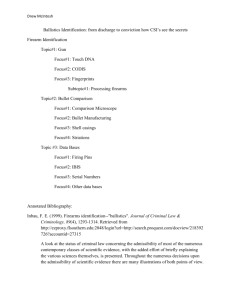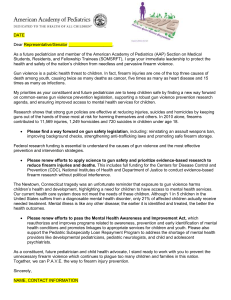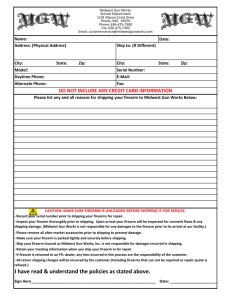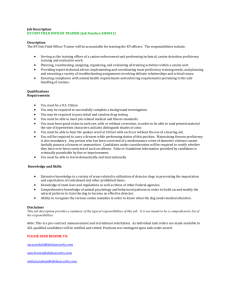analysis of homicidal deaths in district di khan
advertisement
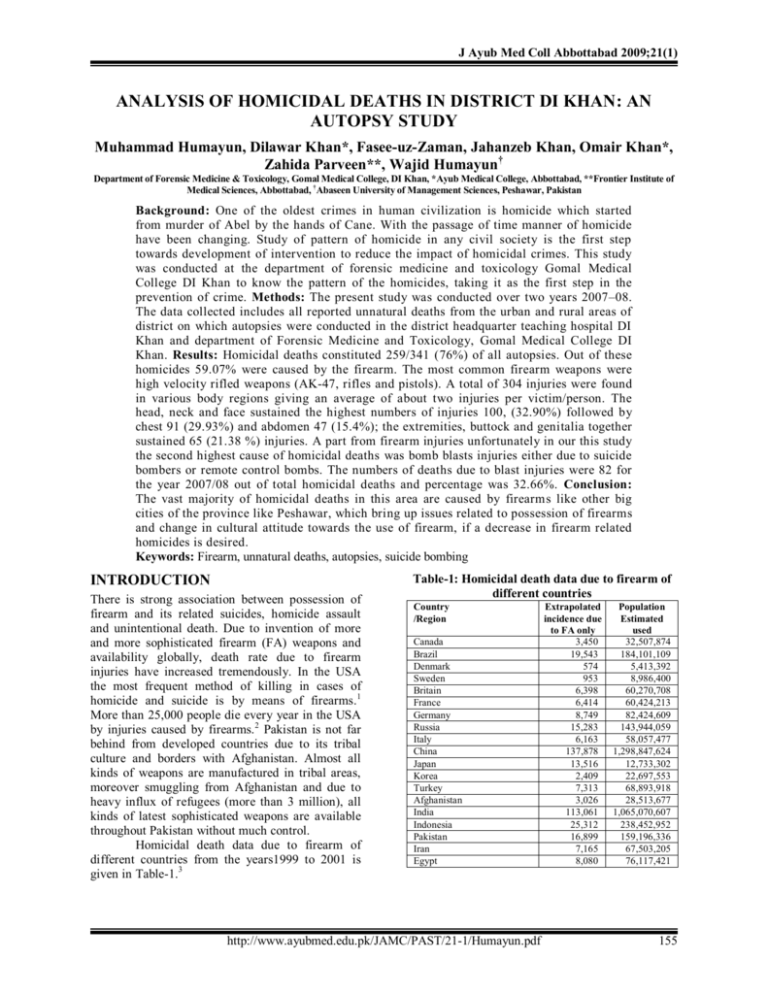
J Ayub Med Coll Abbottabad 2009;21(1) ANALYSIS OF HOMICIDAL DEATHS IN DISTRICT DI KHAN: AN AUTOPSY STUDY Muhammad Humayun, Dilawar Khan*, Fasee-uz-Zaman, Jahanzeb Khan, Omair Khan*, Zahida Parveen**, Wajid Humayun† Department of Forensic Medicine & Toxicology, Gomal Medical College, DI Khan, *Ayub Medical College, Abbottabad, **Frontier Institute of Medical Sciences, Abbottabad, †Abaseen University of Management Sciences, Peshawar, Pakistan Background: One of the oldest crimes in human civilization is homicide which started from murder of Abel by the hands of Cane. With the passage of time manner of homicide have been changing. Study of pattern of homicide in any civil society is the first step towards development of intervention to reduce the impact of homicidal crimes. This study was conducted at the department of forensic medicine and toxicology Gomal Medical College DI Khan to know the pattern of the homicides, taking it as the first step in the prevention of crime. Methods: The present study was conducted over two years 2007–08. The data collected includes all reported unnatural deaths from the urban and rural areas of district on which autopsies were conducted in the district headquarter teaching hospital DI Khan and department of Forensic Medicine and Toxicology, Gomal Medical College DI Khan. Results: Homicidal deaths constituted 259/341 (76%) of all autopsies. Out of these homicides 59.07% were caused by the firearm. The most common firearm weapons were high velocity rifled weapons (AK-47, rifles and pistols). A total of 304 injuries were found in various body regions giving an average of about two injuries per victim/person. The head, neck and face sustained the highest numbers of injuries 100, (32.90%) followed by chest 91 (29.93%) and abdomen 47 (15.4%); the extremities, buttock and genitalia together sustained 65 (21.38 %) injuries. A part from firearm injuries unfortunately in our this study the second highest cause of homicidal deaths was bomb blasts injuries either due to suicide bombers or remote control bombs. The numbers of deaths due to blast injuries were 82 for the year 2007/08 out of total homicidal deaths and percentage was 32.66%. Conclusion: The vast majority of homicidal deaths in this area are caused by firearms like other big cities of the province like Peshawar, which bring up issues related to possession of firearms and change in cultural attitude towards the use of firearm, if a decrease in firearm related homicides is desired. Keywords: Firearm, unnatural deaths, autopsies, suicide bombing INTRODUCTION There is strong association between possession of firearm and its related suicides, homicide assault and unintentional death. Due to invention of more and more sophisticated firearm (FA) weapons and availability globally, death rate due to firearm injuries have increased tremendously. In the USA the most frequent method of killing in cases of homicide and suicide is by means of firearms.1 More than 25,000 people die every year in the USA by injuries caused by firearms.2 Pakistan is not far behind from developed countries due to its tribal culture and borders with Afghanistan. Almost all kinds of weapons are manufactured in tribal areas, moreover smuggling from Afghanistan and due to heavy influx of refugees (more than 3 million), all kinds of latest sophisticated weapons are available throughout Pakistan without much control. Homicidal death data due to firearm of different countries from the years1999 to 2001 is given in Table-1.3 Table-1: Homicidal death data due to firearm of different countries Country /Region Canada Brazil Denmark Sweden Britain France Germany Russia Italy China Japan Korea Turkey Afghanistan India Indonesia Pakistan Iran Egypt http://www.ayubmed.edu.pk/JAMC/PAST/21-1/Humayun.pdf Extrapolated incidence due to FA only 3,450 19,543 574 953 6,398 6,414 8,749 15,283 6,163 137,878 13,516 2,409 7,313 3,026 113,061 25,312 16,899 7,165 8,080 Population Estimated used 32,507,874 184,101,109 5,413,392 8,986,400 60,270,708 60,424,213 82,424,609 143,944,059 58,057,477 1,298,847,624 12,733,302 22,697,553 68,893,918 28,513,677 1,065,070,607 238,452,952 159,196,336 67,503,205 76,117,421 155 J Ayub Med Coll Abbottabad 2009;21(1) MATERIAL AND METHODS The Present study was conducted at the department of Forensic Medicine and Toxicology, over two years (2007–2008). The data collected includes all reported unnatural deaths from the urban and rural areas of the District on which autopsies were conducted in the District Headquarter Teaching Hospital DI Khan and Department of Forensic Medicine, Gomal Medical College DI Khan. A total number of 341 medico legal autopsies were conducted in hospital and department in two years. Cases of homicidal deaths were selected from the total autopsy records on the basis of history of fire arm injury, cloth examination and general physical examination of the dead body. External Examination of the whole body was conducted for the presence of firearm injuries. The injuries were numbered, chartered, the size, shape and exact site of firearm injury related to a fixed anatomical land mark was established. On the diagnostic characteristic of firearm injuries were noted. The injuries were examined with the naked eye as well as with magnifying glass lens. Internal examination of the body included the examination of the viscera and organs in all main cavities. The track of the projectile was followed and the extent of the internal injuries to different viscera and organ was determined. Data was entered on a pro forma and results summarized. RESULTS A total number of 341 unnatural deaths were reported to the department and subjected to autopsy examination during 2007-2008. Homicidal deaths constituted 75% (259/341) of all autopsies for the year 2007–08. Out of these homicides 59.07% were caused by the firearm. The most common firearm weapons were high velocity rifled weapons (AK-47, Rifles, Pistols). A total number of 304 injuries were found in various body areas giving an average of about 2 injuries per victim/person. The head, neck and face sustained the highest number of injuries 100 (32.90%) followed by chest, 91 (29.93%) and abdomen, 47 (15.4%), the extremities, buttock and genitalia together sustained 65 (21.38%) injuries. These are given in the Table-2 and 3. Table-2: Shows distribution of manner of deaths in autopsies (n=341) Manner of death Homicide 1. Firearm 2. Bomb blast 3. Other Cases Accidental Undetermined Suicide Burns Drowning Starvation 156 Number 259 153 82 24 59 3 2 1 13 1 Percentage 76 % 59.07 32.90 9.2 17.13 0.87 0.58 0.29 3.8 0.29 Demographic data regarding firearm injuries is shown in Table-3. The most frequent group was between 16–30 years and 31–45 years group. The age group from 16–45 years together comprises 83% of cases. The victims are exclusively males. Table-3: Demographic data of autopsies of firearm (n=153) Age (Year) 1–15 16–30 31–45 46–60 61–75 Gender Number Percentage 2 1.3 72 47 55 35.94 23 15.03 5 3.26 ALL MALES Table-4: Distribution of firearm injuries by body regions Variables Head, neck, face Chest/thorax Abdomen Extremities Including Buttock and External genitalia Total Injuries 100 91 47 66 Percentage 32.8 30 15.4 21.7 304 100 DISCUSSION Similar to reports from United States, and other developing and developed countries, our studies shows that firearm injuries are the leading cause of homicidal deaths, in the district DI Khan accounting for about 59.75% of such deaths (Table-1). In the United States, firearms are used in more than 60% of all homicides, over 25% of all assaults, more than 35% of all robberies and almost half of all suicides.4 Almost similar is the case in the other developed and developing countries. Our data also agrees with several other studies from various cities of Pakistan where firearm victims were the leading cause of homicidal deaths.5 However, study from Karachi6 conducted in the year 2002 indicates that firearm injuries and road traffic accidents together are the common cause of medico legal autopsies; this may inversely indicate the pattern of busy city faced with an increasing traffic load. Almost all age groups were represented with the majority being in the adult and middle aged persons (16–45). Other studies from Pakistan also agree that the most common victims of firearm related homicides are young and middle aged adults. Surprising enough, all the victims were exclusively males, as the case was in another study conducted in this district in 2004.7 A total of 304 injuries were recorded in 153 autopsies giving an average of about 2 injuries per person. It is obvious that one of these injuries was a lethal injury resulting in the death of the victim. Upper regions of the body comprising of the area including the thorax and the above were the most common sites of the firearm injuries accounting for 63% of the total injuries (Table-4), these were the most lethal http://www.ayubmed.edu.pk/JAMC/PAST/21-1/Humayun.pdf J Ayub Med Coll Abbottabad 2009;21(1) ones. The remaining injuries were of the abdomen and extremities including buttock and genitalia. Similar reports have been obtained from other places in the country like Karachi, Peshawar and Larkana.6,8,9 It is of the notable concern that homicidal deaths due to firearm weapons are not confined to major cities of NWFP like Peshawar, Mardan, Charsadda, DI Khan, Kohat, Bunnu which have border with tribal areas and are near to Afghanistan, but the homicidal deaths due to firearms are almost double in other major cities of Pakistan like Lahore, Karachi, Rawalpindi and Faisalabad, which means that firearms are sold legally and illegally through out the country without much control. In a study from Lahore during the period from 1984–199510, it was observed that the incidence of firearm related homicidal deaths was double from the past. They also noted that a change in the type of firearm from short gun in the early years to high velocity rifled weapons towards the later part of the study period. Considering the data from the present study there is a need for strict control over possession of firearm in DI Khan and other big cities of Pakistan as well as educating both elders and young adults about the hazards posed by possession and irrational use of firearm either for offence or defence (owning a gun may moderately increase the likelihood of fatally shooting another person. Is access to a gun protective or an increased risk factor for the firearm owner to be killed? A gun in the home is a risk factor for household members to be shot fatally in their homes.11 Use can be made of existing Jirga system for preaching human and ethical value system to replace the feudal value system. Additional controls are required over the tribal areas adjacent to DI Khan (Waziristan) and Dara Adam Khel adjacent to Peshawar where firearm manufacture should be discouraged by law or only licensed firearm should be allowed for sale. Additional measures to provide early and effective emergency medical treatment to firearm victims to reduce the number of fatalities related to firearm injuries should be taken.12 In view of the need to control and decrease illegal trafficking of firearms, the United Nations crime prevention and justice commission recently passed a resolution encouraging all countries to strengthen their domestic gun control. Since weak control in one country can affect the security in others. This was the one side of picture. Other side is more horrible that is suicide bombing and remote control bombing. In the year 2008, 889 peoples were killed and more than 2072 were injured in about 61 suicide bombing. At least for 29 times suicide bombers struck in NWFP. The total no. of suicide blasts in Pakistan since 2002 has risen to 140 to date. While, 56 bombers had struck in year 2007. In one such attack former Prime Minister, Mohtarma Benazir Bhutto, whose first death anniversary was observed on Dec 27, 2008 was killed in Rawalpindi. In DI Khan city there were only 5 suicide bombing and 3 remote control bombing in year 2007–08 in which 82 persons including police and civilians were killed and more than 221 were injured as mentioned earlier under heading of introduction in the present study. Here in this part of the country, suicide bombing is not by the hand of terrorist only, sectarian rivalry among the Shia and Sunni religious groups may be other cause. A part from control on firearms by different means sectarianism needs immediate intervention at national, provincial and local level between elders and Ulama of both groups. If not controlled, this will cross the provisional border and sooner or later, whole country will be in trouble. REFERENCES 1. 2. 3. 4. 5. 6. 7. 8. 9. 10. 11. 12. Wintemete CJ, Teret SP, Kraus JF, Wright MW. The choice of firearm suicide. Am J Public Health 1989; 79:824–6. Fateh A. Gunshot wounds in forensic pathology, 11th edition, Phildelphia: J.B. Lippincott Co; 1973.p.79. Statistics by country for Firearm Injury. URL: http://www.wrongdiagnosis.com/f/firearm_injury/stats-country.htm Forest De, Ganesslen ER, Lee CH. Tool marks and firearm. In: Forensic Sciences: An Introduction to criminalistics, 1st edition, New York: McGraw Hill; 1983. p. 383–412 Mian AR, Majid A, Malik MM, Zaheer M, Goraya SU. Analysis of unnatural Death in Rawalpindi during 1997. Pak Armed Forces Med J 1999;49(1):68–70. Bashir MZ, Saeed A, Khan D, Aslam M, Iqbal J, Ahmed M. Pattern of homicidal deaths in Faisalabad. J Ayub Med Coll Abbottabad 2004;16(2):1–3. Mujahid M, Hassan Q, Arif M, Gandapur J, Shah H. Homicidal deaths by firearms in Dera Ismail Khan: an autopsy study. Pak J Med Res 2006;45(1):14–6. Memon MU, Khalil ZH, Aziz K, Kaheri GQ, Khalil IR. Audit of Cases Autopsied in the Mortuary of Khyber Medical College Peshawar during the year 1999. Ann King Edward Med Coll 2001;7(3):190–3 Qadir G, Aziz K. The study of homicides in Larkana. Pakistan Postgraduate Med J 2000;11(2):79–80 Bashir Z, Rana PA, Malik SA, Shaheen A. Pattern of Deaths due to firearms in Lahore– A twelve-year study. Pakistan Postgrad Med J 2000;11(3):109–14. Kellermann Al, Rivara, FP, Rushforth NB, Banton JG, Reay DT, Francisco JT et al. Gun ownership as a rish factor for homicide in the home. N Engl J Med 1993;329(15):1084–91. Bashir MZ, Malik AR, Rana PA, Malik SA, Shaheen MA, Khokhar JI et al. Firearm Related Deaths in Lahore; A Need for Efficient Emergency Services. Ann King Edward Med Coll Jun 2001;7(2):102–5. Address for Correspondence: Dr. Muhammad Humayun, Assistant Professor, Department of Forensic Medicine, Gomal Medical College, DI Khan, Pakistan. Cell: +92-300-5627879 http://www.ayubmed.edu.pk/JAMC/PAST/21-1/Humayun.pdf 157

